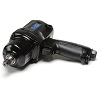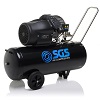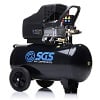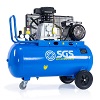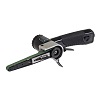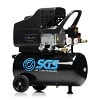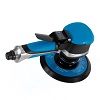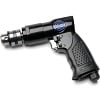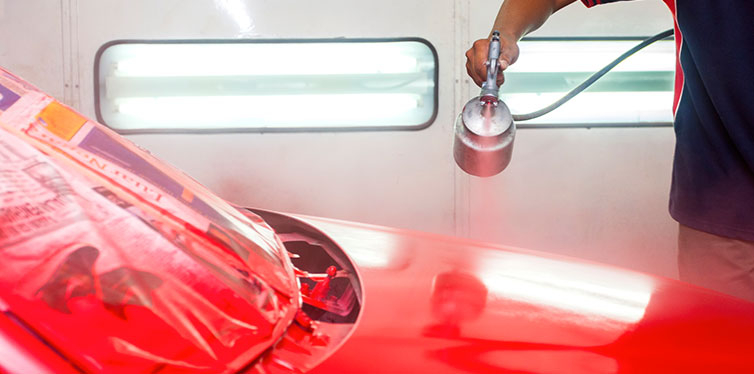CFM means Cubic Feet per Minute and this is the volume of air an air compressor can pump out per minute.
When buying an air compressor the first thing you must work out is how much air is needed to power your tool. To figure this out you need to know how much air flow your tool requires to run. Almost all air tools have specific requirements in regards to air volume and pressure.
You must meet these requirements with your chosen air compressor for the tool to function at its best. The CFM requirement and the tank are are the biggest considerations you must take into account when shopping for a compressor. You can find the CFM requirement of your tool from it's manual or technical specification.
In this guide we will cover;
- How much air do you need to run an impact wrench?
- What size air compressor do I need for a finish nailer?
- What is the best compressor for spray painting?
- How many CFM do I need for sandblasting?
- What CFM do I need for sanding?
- What CFM do drills and screwdrivers need?
- What CFM do grinders and cut off saws need?
- What size air compressor do I need to paint a car?
Calculating CFM Requirements
Find the required air flow (CFM) of your specific air tool. This information will be in your tools user guide or manufacturers website.
To find the minimum required CFM of the compressor you need multiply your tool’s required CFM by 1.5
Example: if you want to run a spray gun (6.5 CFM):
6.5 CFM x 1.5 = at least a 9.75 CFM compressor
If you’re going to be running multiple tools you’ll need to add together the individual CFM of each tool. Most DIY compressors are designed to run only one tool at a time. You can successfully run several tools simultaneously on larger more commercial compressors.
Calculating Tank Size
To find the minimum tank size of the compressor you need multiple your tool’s required CFM by 6.
For example, if you run an impact wrench (8 SCFM):
8 CFM x 6 = at least a 48 litre compressor tank
Again, this is a rough guide and the larger tank your compressor has, the better the performance of your tool.
How much air do you need to run an impact wrench?
| Tool | Tool Requirements | Air Compressor |
SAT103 | CFM - 6.5 CFM Max Torque - 340 Nm Operating Pressure - 90 PSI | SC90B |
SC100V | ||
SAT101 | CFM - 8 CFM Max Torque - 880 Nm Operating Pressure - 90 PSI | SC100V |
What size air compressor do I need for a finish nailer?
| Tool | Tool Requirements | Air Compressor |
SAT402 | CFM - 1 CFM Operating Pressure - 60-100psi | SC6H |
SAT403 | CFM - 1 CFM Operating Pressure - 75 - 100psi | SC6H |
SAT404 | CFM - 6.5 CFM Operating Pressure - 70 - 100psi | SC50H |
SAT405 | CFM - 14.8 CFM Operating Pressure - 75 - 100psi | SC100V |
What is the best compressor for spray painting?
| Tool | Tool Requirements | Air Compressor |
SAT502 | CFM - 6 - 12 CFM Operating Pressure - 36 - 50 psi | SC100V |
SAT501 | CFM - 6 - 12 CFM Operating Pressure - 36 - 50 psi | SC150B |
SAT505 | CFM - 6 - 11 CFM Operating Pressure - 36 - 50 psi | SC90B |
How many CFM do I need for sandblasting?
| Tool | Tool Requirements | Air Compressor |
SSB100 | CFM - 10 CFM Operating Pressure - 80 - 100 psi | SC90B |
SSB200 | CFM - 10 CFM Operating Pressure - 100 psi | SC150B |
SSB400 | CFM - 24 CFM Operating Pressure - 125 psi | S-N1NN905FPS019 |
What CFM do I need for sanders?
| Tool | Tool Requirements | Air Compressor |
SAT610 | CFM - 4 CFM Operating Pressure - 90 psi | SC6H |
SAT603 | CFM - 4.5 CFM Operating Pressure - 90 psi | SC6H |
SAT604 | CFM - 6 CFM Operating Pressure - 90 psi | SC24H |
SAT601 | CFM - 5 CFM Operating Pressure - 90 psi | SC100V |
SAT602 | CFM - 4.5 CFM Operating Pressure - 90 psi | SC100V |
SAT606 | CFM - 5 CFM Operating pressure - 90 psi | SC100V |
What CFM do drills and screwdrivers need?
| Tool | Tool Requirements | Air Compressor |
SAT203 | CFM - 6 CFM Operating Pressure - 90 psi | SC24H |
SAT206 | CFM - 5.5 CFM Operating Pressure | SC24H |
SAT204 | CFM - 6 CFM Operating Pressure - 90 psi | SC24H |
SAT205 | CFM - 5 CFM Operating Pressure - 90 psi | SC24H |
What CFM do grinders and cut off saws need?
| Tool | Tool Requirement | Air Compressor |
SAT303 | CFM - 4.5 CFM Operating Pressure - 90 psi | SC6H |
SAT304 | CFM - 4 CFM Operating Pressure - 90 psi | SC6H |
SAT305 | CFM - 6 CFM Operating Pressure - 90 psi | SC24H |
What size air compressor do I need to paint a car?
Painting your car at home is a big job, however when done properly it can offer a very affordable option. There are several elements that can influence the outcome of your paint job. Ensuring you have the correct size compressor should be top priority, after deciding on the colour of course. If you're attempting to use a small air compressor, you simply won’t have the volume (CFM) to paint your entire car in one go. Your gun will struggle as will your air compressor.
While it is possible to paint your car in steps with a smaller air compressor, you will very likely run into problems with over-spray, especially on the clear coat stage. Over-spray from the clear coat will cause your job to look dull. Painting is a very demanding job, one that requires consistent power. Because you’ll be painting continuously, you’ll want to make sure you're using a compressor that is a big enough size to maximise your efficiency. Spray guns require a significant amount of power to operate. Therefore, it’s important that you pay attention to these factors when shopping for an air compressor.
100 Litre Air Compressor
The SGS 100 litre reciprocating air compressor is ideal for DIY and trade applications thanks to it's impressive 100L capacity tank. This coupled with a very high 14.6 CFM air displacement, offers a fantastic combination of performance, safety and value for money. The large air tank makes this compressor suitable for tools that require a constant supply of air, such as spray guns, impact wrenches and drills. The powerful 3 HP engine ensures a short wait for the tank to pressurise - keeping you working.
150 Litre Air Compressor
This air compressor is is a must for professional workshops, garages and enthusiasts alike. It is extremely effective thanks to it's large 150L capacity tank coupled with it's very powerful 14cfm air displacement. Using the long life highly efficient, smooth and quiet operating 14cfm, twin cylinder belt drive compressor pump, the compressor works up to a maximum working pressure of 150 PSI. This machine uses an industrially rated induction motor and must be operated from a heavy duty power supply and not from extension cables.
Still need help?
Our in house experts are always on hand for buying advice and to provide bespoke care, regardless of the application.
Call SGS on 01332 576 850 or fill out our contact form today.



